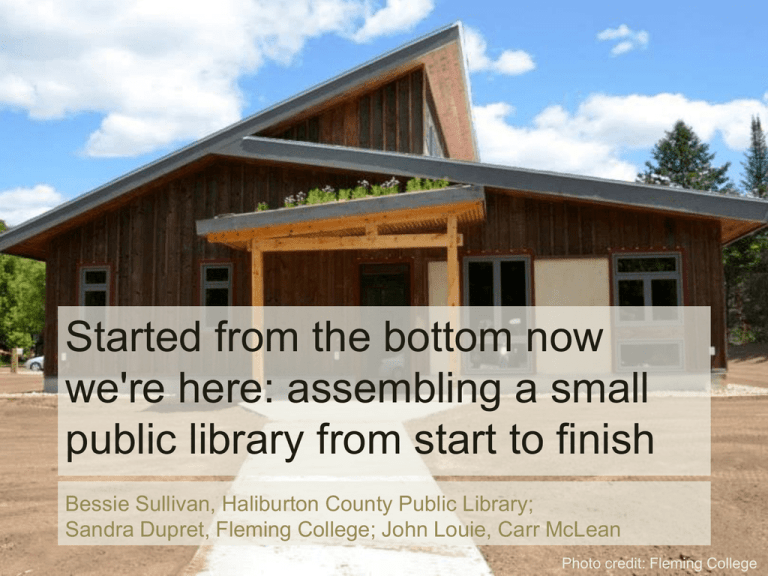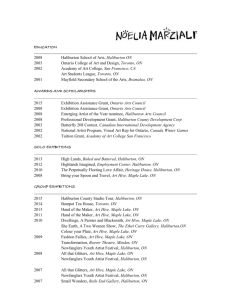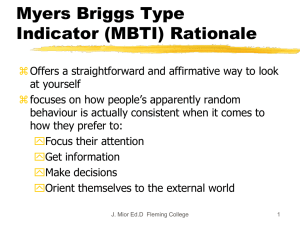Started from the bottom now we`re here: assembling a small public
advertisement

Started from the bottom now we're here: assembling a small public library from start to finish Bessie Sullivan, Haliburton County Public Library; Sandra Dupret, Fleming College; John Louie, Carr McLean Photo credit: Fleming College Started from the bottom now we're here: assembling a small public library from start to finish The bottom: •Local Demographics •Establishing need •What we had The assembly: •Fleming College’s Sustainable Building and Design program The finish: •Layout and Design •Moving the branch •What we have now Photo credit: Fleming College Wilberforce, Ontario Municipality of Highlands East •~230 km NE of Toronto •1,493 year-round households (19.6% of Haliburton County) •3,249 year-round residents •4,374 private dwellings including seasonal •Average housing price $156,620 (range sub $100,000 to plus $700,000) •Median income $38,491 per household (average $47,161) “[The Wilberforce branch is a] stand-alone building that was not designed for library services. The building is inaccessible, dark, and cramped.” SOLS Needs Assessment, 2003 ARUPLO Guidelines What we had 757 square feet 3,200 items 11.5 hours/week What we should have 2,500 square feet 7,500 items 20 hours/week Serving a user population of 1,000 – 5,000 Accessibility for Ontarians with Disabilities Act “When fire trucks wear out you replace them. When libraries wear out you replace them.” Joan Barton, Highlands East Councillor (Haliburton County Echo, November 27, 2012) “I am a firm believer that the only way to reduce costs for the Municipality is to build better, more sustainable buildings. Cutting programs and services can only continue for so long.” Steve Kauffeldt, Highlands East Councillor “Not only is this building a gathering place, its construction became a community effort.” Bessie Sullivan, CEO/County Librarian HCPL (Bancroft Weekly, June 24, 2014) Photo credit: The Highlander The Library Launchers Photo credit: The Highlander “Highlighted in the Haliburton County Public Library’s statement of values is sustainability; this project with Fleming College’s Sustainable Building Design and Construction program fits beautifully into our mandate.” Bessie Sullivan, CEO/County Librarian HCPL (Media Release, Fleming College, November 28, 2012) Sustainable Building Design and Construction What is Fleming College’s Sustainable Building Design and Construction Program? The program provides 26 students theoretical and hands-on experience with leading edge sustainable building practice through the actual construction of a fullscale, public building that incorporates the most sustainable options available The buildings created are open to the public as functional, living examples of sustainable technologies, materials and philosophies in building science. Our Partnerships We engage in partnerships with municipal governments and not-for-profit agencies to: Create functional, high performance, sustainable community buildings Contribute significant labour to community projects Involve the community in the sustainable building process through education and participation Partner with local trades and suppliers to source all materials and services locally Curriculum to DO THIS Intense 20 week Ontario One Year certificate; students are in class 45 hrs/week Balance of classroom and job site time; 30% classroom and 70% construction site Team based approach shared by faculty and students Committed community partner and exciting project able to meet z sustainable curriculum requirements Leading practitioners to teach, design and lead students through construction Complete a structure that exemplifies leading edge sustainable practices 4C’s Food Bank and Thrift Shop - Haliburton Kinark Outdoor Living Centre - Carnarvon R.D. Lawrence Place - Minden Performing Arts Centre - Madoc Camp Kawartha Environment Centre at Trent Habitat for Humanity - Peterborough Camp Maple Leaf- Pigeon Lake Abbey Gardens – West Guilford Wilberforce Branch Start here: End here: So you want to build a library? Where do we start? Initial discussions between Fleming College and the Municipality of Highlands East Research involved touring Haliburton County Libraries and meeting with staff for discussions of pros and cons of existing facilities Staff feedback, client needs, budget allocation and curriculum requirements contributed to the overall design The design process involved Haliburton County Library CEO Bessie Sullivan, Havencraft Design, Fleming College Sustainable Building faculty and staff– Pat Marcotte, Ali Lam, Chris Lalonde, Ted Brandon, Levitt Goodman Architects, structural engineer Tim Krahn (Building Alternatives) and the Municipality of Highlands East Council Common 24" PCT 3-ply 2x8 Lintels above windows Droppped 24" PCT w' ladder truss overhangs 2x10 Sub fascia 2' 7x11.25" LVL beams below SIP's Double 2x10 Sub fascia @ SIP ends 2x10 framing for SIP extension along gable ends 3'-11" 7"x16" LVL or PSL Centre Beam on 8x8 posts 2'-107/16" 4-ply 2x12 beam (does it need to be here along side wall?) 5'-11/2" 4'-91/2" 4'-97/16" 4'-59/16" 5'-89/16" 6'-8 1/16" 4'-9 5'-89/16" 7'-1/8" 7'-115/16" 7/16" 6x6 posts Red line denotes bale wall What is a Sustainable Building? Students are installing the Insulated Concrete Foundation (ICF) Staining exterior siding using non-toxic finishes. Locally sourced, sustainable harvested post & beam frame & timber frame features External features Passive solar design capturing the sun’s heat in winter and blocking heat in summer Clerestory roof design to allow natural sunlight to reach the entire floor area Structural Insulated Panel (SIP) roofing for highly efficient roof system Galvanized roofing for a cooler temperature roof and rainwater collection Rainwater collection cistern for landscaping/grounds maintenance usage Enviroshake (shingles made of recycled tires & rubber) siding as well as locally sourced board & baton Triple glazed fibreglass windows Green roof on entry If these walls could talk…… Straw bale walls with hand applied local, natural clay & lime plaster OR Interior wall board (drywall) made from recycled Tetra-paks insulated and resource efficient double stud walls with recycled newsprint (cellulose) insulation What do we see? Natural sunlight. Both locally cut timbers and reclaimed timbers were used in construction. Natural Marmoleum flooring made of linseed oil. Fully accessible and barrier free design. Artistic Features Usable Space What’s next? BCT – Youth in Action Canteen THANK YOU Sustainable Building Design and Construction Ted Brandon, Administrative Coordinator Patrick Marcotte, Academic Coordinator and Faculty Ali Lam, Faculty Eric Lewis, Project Manager (current) Chris Lalonde, Wilberforce Library Project Manager (past) Finishing touches September 2013 – February 2014 • September 2013 – Fleming students wrap up their program. – Local contractors hired to finish trim, flooring, HVAC, mechanicals, etc. – Determined that landscaping and paving would need to be completed in spring 2014. • December 2013 – Community survey to determine new and expanded hours for new branch. • February 2014 – First batch of Carr McLean furnishings arrived and assembled. Layout and Design Carr McLean's initial involvement in furnishing the Wilberforce Library started in July 2013. Tender was submitted based on the product descriptions and layout provided within the tender. Layout and Design Layout and Design Although the form and function of library spaces continue to evolve, all libraries of any scale still have commonalities with respect to furnishings. 1. 2. 3. 4. 5. 6. Circulation desk and or Information desk Shelving Tables and chairs for reading and computer areas Children's area Lounge seating Display Layout and Design Layout and Design Typically the actual products supplied will vary from the initial scope of products specified. 1. The initial assessed needs may change. 2. Further discussion of product features and how they function may alter product selection. 3. The as-built site measurements of the library may affect spacing and location of furniture. 4. Accessibility to the actual locations of floor mounted electrical and data outlets may impact the placement of furnishings. 5. The actual locations of windows, window sills, switches, control panels, as well as electrical and data outlets may result in changes to quantity, size and location of shelving. Layout and Design Finishing touches March 2014 – June 2014 • March 2014 – Ontario Trillium Foundation Grant awarded, allowing us to purchase additional furnishings. • April 2014 – Snow finally melts and landscaping commences. • May 2014 – Book moving campaign begins. • June 2014 – Second batch of Carr McLean furnishings arrives. – Moving into the new branch, and opening. “It’s getting them [the patrons] involved in a way that’s Erin Kernohan-Berning, Branch Services Librarian HCPL kind of fun.” (Haliburton County Echo, May 27, 2014) Wilberforce book moving campaign: • Borrowed from a similar campaign in Bridgewater, Nova Scotia. • Patrons were encouraged to check out a bag of books from the old branch and keep them until the new branch opened. • Patrons returned books to new branch, and all fines were waived for 2 months after opening. Saw approximately 50% increase in circulation during the campaign. Photo credit: Haliburton County Echo Moving the Library ARUPLO Guidelines What we had 757 square feet 3,200 items 11.5 hours/week What we have now 2,200 square feet 4,000 items 16 hours/week What we should have 2,500 square feet 7,500 items 20 hours/week Serving a user population of 1,000 – 5,000 “We did it together. It does take a community to build a library. You guys are a part of it, you guys Dave Burton, Highland’s East Reeve own it. Enjoy.” (The Highlander, June 26, 2014) Photo credit: The Highlander








